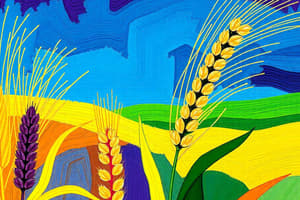Podcast
Questions and Answers
What are grains commonly referred to as?
What are grains commonly referred to as?
cereals
Which of the following are types of grains? Select all that apply.
Which of the following are types of grains? Select all that apply.
- Wheat (correct)
- Oats (correct)
- Rice (correct)
- Potatoes
Oats are naturally rich in beta-glucan, a soluble fiber.
Oats are naturally rich in beta-glucan, a soluble fiber.
True (A)
Grains are commonly referred to as '______'.
Grains are commonly referred to as '______'.
Match the grain with its unique feature:
Match the grain with its unique feature:
What is the most widely cultivated cereal crop in the world?
What is the most widely cultivated cereal crop in the world?
Flashcards are hidden until you start studying
Study Notes
Grains
- Grains are commonly referred to as 'cereals' and are edible seeds.
- Examples of grains include wheat, oats, rice, corn (maize), barley, sorghum, rye, and millet.
- Within these groups, there are varieties, such as couscous, burghul, freekeh, emmer, and spelt.
Wholegrain
- A wholegrain is a grain that contains all the essential parts: the endosperm, germ, and bran, and the naturally-occurring nutrients of the entire grain.
Wheat
- Wheat is the most widely cultivated cereal crop in the world.
- Wheat has become a favorite grain due to its diversity in culinary applications.
- Flour is most commonly made from wheat, but can also be made from corn, rice, rye, and barley.
Oats
- Oats are unique in that they almost never have their bran and germ removed in processing, so most food containing oats as an ingredient are considered wholegrains.
- Oats are naturally rich in beta-glucan, a soluble fiber that has been shown to improve blood glucose control, improve insulin responses, and decrease cholesterol levels.
- Oats also have a unique antioxidant, Avenanthramide, that helps protect blood vessels from the damaging effects of LDL cholesterol.
Rice
- Rice is one of the most eaten grains in the world, grown in over 100 countries.
- Rice is the staple food of three of the most populated regions of the world: China, India, and Indonesia.
- There are over 100 varieties of rice, including white rice, basmati rice, brown rice, arborio rice (Italian), black rice, and sushi rice.
Corn
- Corn is one of the world's most important crops, used widely in food manufacturing.
- Corn is used to make corn starch, corn flour, breakfast cereals (cornflakes), and tortillas.
Grain Production
- Global grain production growth will be due to higher yields and more intensive use of existing arable land.
- The expected increase is attributed to the wider availability and adoption of new and improved seed varieties, more intense and efficient use of inputs, and improved agricultural practices.
- Global production of cereals is projected to increase from its current level by about 320 Mt to 3.1 Bln T by 2032, largely from maize and rice.
Consumption
- Grain crops are mainly used for human consumption, animal feed, and biofuels.
- Asian countries will lead demand growth of cereals for food and feed.
- Cereal demand will continue to be dominated by food use, closely followed by animal feed use.
Trade
- Global cereal trade will increase by 11%, totaling 530 Mt by 2032, with wheat contributing to 43% of this growth, maize: 34%, rice: 20%, and other coarse grains: 3%.
- The Russian Federation is projected to remain the largest wheat exporter, supplying 23% of global exports in 2032.
Harvest Area
- Since 1960, grain harvest area has increased slightly, while production levels have risen dramatically.
- Grain production has increased 269% since 1961, while grain harvest area has only increased 25%.
- The increase in production and the significantly smaller increase in harvest area are largely due to the Green Revolution and the introduction of high-yielding grain varieties.
Factors Affecting Grain Crops
- The reliance on grain crops for food security is threatened by extreme climatic events, especially droughts and floods.
- Climate change is expected to affect agriculture, leading to 10-20% more people being subject to hunger by 2050, and 24 million more children being malnourished.
- The 2012 drought in the Midwest and Great Plains of the U.S. is considered the worst drought in 50 years, expected to cost billions of dollars and affect the global market.
Studying That Suits You
Use AI to generate personalized quizzes and flashcards to suit your learning preferences.




